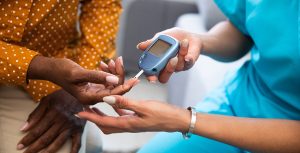For people living with diabetes, a ray of hope has emerged from an unexpected source — the natural sunlight.
A groundbreaking study presented at the annual meeting of the European Association for the Study of Diabetes sheds light on the potential benefits of soaking in the sun for individuals battling Type 2 diabetes.
Discussing the findings, a researcher at the department of Nutrition and Movement Sciences at the Maastricht University, Ivo Habets, says, “Our research shows that the type of light you are exposed to matters for your metabolism.”
He calls the findings “a simple, yet profound, revelation;” adding, “Embracing natural light can significantly impact metabolism, potentially changing the trajectory of diabetes management.”
The study, led by a team of dedicated researchers, involved 13 adults with Type 2 diabetes with an average age of 70 years. They embarked on a randomized crossover journey, dividing their time between natural daylight and artificial light.
 From 8.00am to 5.00pm, participants were randomly assigned to either bask in the natural sunlight streaming through the windows or undergo an artificial light intervention, featuring consistent exposure to LED lights.
From 8.00am to 5.00pm, participants were randomly assigned to either bask in the natural sunlight streaming through the windows or undergo an artificial light intervention, featuring consistent exposure to LED lights.
The evening hours — 5.00pm to 11.00pm — were dimly lit, with darkness reigning supreme during the sleeping hours of 11.00pm to 7.00am. Each intervention spanned 4.5 days, with participants switching to the opposing light source after a four-week washout period.
Continuous glucose monitors were attached to their bodies throughout the experiment.
On day four of the study, indirect calorimetry was used to measure energy intake and 24-hour substrate metabolism. Blood samples were diligently collected to assess circulating metabolites, while a telemetric pill allowed the monitoring of the core body temperature around the clock.
Day five saw a fasting muscle biopsy, providing insights into the clock gene’s expression, followed by a mixed meal tolerance test.
The results were nothing short of remarkable, the researchers noted.
Participants exposed to natural daylight spent significantly more time within the normal glucose range of 4.4 mmol/L to 7.8 mmol/L, compared to their counterparts subjected to artificial light (P =,01).
Furthermore, those bathed in natural daylight exhibited lower respiratory exchange ratios over the course of a 24-hours day (P=,028).
The difference was especially pronounced at 1.00pm; underscoring the significance of sunlight exposure. Notably, there were no notable changes in resting energy exposure, plasma glucose levels, free fatty acids, triacylglycerol levels, or core body temperature between the two groups.
During the mixed meal test, whole-body energy expenditure remained consistent across the board. However, the natural daylight intervention yielded a lower respiratory exchange ration compared to artificial light P=,04.
Lead researcher Ivo Habet says he believes that this discovery offers a beacon of hope for diabetes management, while emphasizing the importance of evaluating and altering patients’ exposure to natural or artificial light, as it presents a simple, yet impactful, avenue.
This study’s findings underscore the potential for small yet significant enhancements in glucose control findings and respiratory exchange ratios.
Habet says, “In a world often characterized by the complexities of medical treatments, the sun’s warm and radiance offer a surprisingly accessible and promising path towards better health for individuals living with Type 2 diabetes.
“So, next time you find yourself in an office devoid of natural light, consider stepping into the sun, for it may hold the key to brighter days ahead in the fight against diabetes.”


